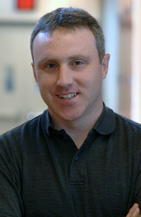
29 Jun TSRC Town Talk: Nanoscience & Nanotechnology for Sustainable Energy
Come hear Todd Krauss, former TED speaker & PhD Professor of Chemistry, University of Rochester, talk about his research in gathering solar energy more efficiently with light harvesting quantum dots, a new technology that will lead us into a more sustainable future. Tuesday, June 30, 6 p.m.; cash bar, 5:30 p.m. Free admission. Sponsored by Telluride Science Research Center.
In everyday life, when something is cut in half the physical properties of the object remain the same. If a cookie is split in two, nothing changes; it’s still the same cookie, just in pieces. But in the nanomaterial world—the world of small particles—this isn’t always true. Splitting particles can have major consequences that could lead to more sustainable energy.
“Nanomaterials, in particular lead and cadmium, have this unique property where if you change the size of the particle, you change it completely. At some point, you reach a position on the nanometer scale where if you break a quantum dot in half, you change its properties dramatically. If it’s optical, electronic, or vibrational properties, you change the fundamental physics,” says Todd Krauss, Professor of Chemistry and Professor of Optics at the University of Rochester.
Quantum dots are nanocrystals made of semiconducting materials, which are small enough to exhibit quantum mechanical properties. In other words, they’re conductive, incredibly tiny tubes, usually one atom thick, that follow strange rules set out by the subatomic world.
Krauss will talk about the history of nanomaterials and the potential applications of quantum dots for developing more sustainable sources of energy at the next TSRC Town Talk on June 30, 2015.
“It’s a different way of thinking about materials, and that’s a breakthrough, much in the same way as over 50 years ago we learned that light doesn’t have to be incoherent. Light isn’t just a light bulb or a candle, it can be a laser, focused, directed and coherent,” Krauss says.
DVD players, barcode scanners, and golf range finders now exist because of lasers, which couldn’t have been predicted before the discovery of lasers.
The real application that quantum dots have today is in light-emitting diodes (LEDs) and displays like televisions or electrical displays such as organic light-emitting diodes (OLEDs), where a film of an organic compound emits light in response to an electric current. OLED displays can be found on car stereos or digital watches.
If the organic compound could be replaced with a quantum dot, explains Krauss, “you could some day have new quantum dot OLEDs, or quantum dot displays and quantum dot solar cells.”
In fact, Krauss and his team are trying to solve a longstanding problem with solar energy: how to make it cost- and energy-efficient in places where sun isn’t available in the winter. In places like Rochester, New York, for example, fuel such as gas is much more efficient because it has a high-energy density. To make a more efficient and sustainable source of power, Krauss’ team wants to create solar fuel by using quantum dots to harvest visible and infrared light and use that energy to drive catalytic reactions. This means taking solar energy and converting it to chemical bond energy in order to break those bonds and make power for a car or a house.
The nanomaterial world can potentially affect what we observe in major ways. Come to the Mountain Village Conference Center, Tueday, 6/30, 6 p.m. to learn about the implications of Krauss’ research and what may be the next big discovery in science.
Sponsored by the Telluride Science Research Center, admission to the event is free. Cash bar starts at 5:30 p.m. For more information, visit telluridescience.org.



Sorry, the comment form is closed at this time.